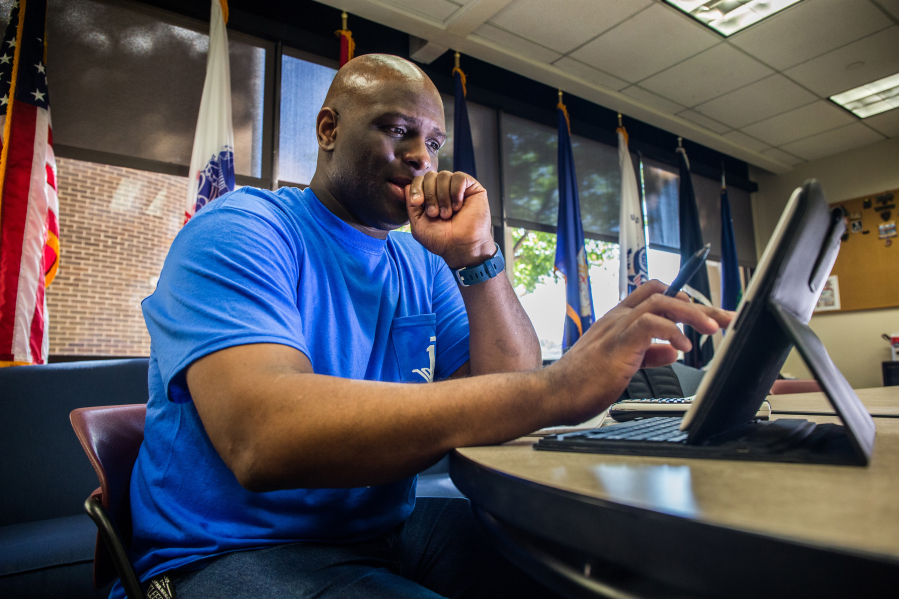CHICAGO — Richard Green graduated from high school 20 years ago, eager to get a college degree in computer science and launch a career.
So when a recruiter from what was then DeVry Institute of Technology told him he could finish his bachelor’s degree in three years instead of four, he signed on. “You want to be something by a certain time frame,” said Green, of the Chicago suburb of Matteson.
But that decision ended up long delaying the independence Green sought.
Green, 38, just this summer went through the graduation ceremony at Prairie State College, an area community college, posing for a photo in his cap and gown draped in more than a dozen honors medals and stoles.
He is proud of his accolades. But he also says he is on food stamps. He still has two classes to finish to get his degree and juggles school with part-time jobs at GameStop and overnight shifts at 7-Eleven.
As Green continues to pay down federal loans he took out to attend DeVry, the life he hoped to jump-start still struggles to get off the ground.
“I shouldn’t have to go through all that trouble just to get to where I need to go,” he said.
Students seeking to improve their lot in life often look to college for a leg up, but a lack of information and an urgency to land a job can drive youth from lower-income communities to enroll in for-profit trade schools they often can’t afford.
Students trying to climb out of poverty tend to receive less guidance about their college choices than their more well-heeled peers. Those who opt for for-profit schools sometimes find themselves in greater debt while enrolled in programs that are less flexible when it comes to shifting gears or transferring credits.
As a result, big generational gains in high school completion are thwarted at the college juncture.
“What we’re seeing here is a real loss of potential,” said Stefanie DeLuca, an associate professor of sociology at Johns Hopkins University in Baltimore who has studied the issue.
The for-profit industry, whose reputation has taken a beating in recent years with a spate of fraud investigations, lawsuits and tightening regulations, said its purpose is the opposite.
“Our schools provide that bridge to a better skill, a better income, a real place in the middle class,” said Steve Gunderson, CEO of Career Education Colleges and Universities, an industry trade group. Without them, he said, “for many of these students there would be no chance.”
DeLuca co-authored a study, published in the October issue of the Sociology of Education, that examined the post-secondary decisions of low-income black 15- to 24-year-olds in Baltimore.
She found many of the 150 students in the study who ended up at for-profit trade schools were trying to make the best decision they could with little information beyond what they saw on advertisements. Most had modest goals, wishing to become truck drivers or certified nursing assistants, and thought they were choosing short college programs that laid out a straightforward path to a career.
Yet many didn’t end up finishing.
Like other 18-year-olds, some discovered the career they thought they wanted wasn’t the right fit. But transitioning from phlebotomy to an HVAC technician career track is not as easy as switching majors at a nonprofit college, and some had to start over in new programs, or even new schools, racking up more expenses.
Those who completed their postsecondary programs often found themselves in jobs that didn’t pay a living wage, DeLuca said.
DeVry, now known as DeVry University, said DeLuca’s research doesn’t apply to the school because the research focused on certificate programs, not the degree programs that DeVry offers in business, technology and health care technology. DeVry’s students are “busy, working adults with a millennial mindset, who are often balancing the demands of school, work and family life,” said spokeswoman Donna Shaults. DeVry is accredited by the Higher Learning Commission, the nation’s largest regional accreditor.
Green dropped out of DeVry in 1999 just a few classes shy of completion because he was told he was no longer eligible for financial aid.
He joined the Army for its loan repayment program, but left on a medical discharge before he could take advantage of it. He spent the next decade working various jobs in retail and call centers in an effort to dig out of debt before starting school over again.
He wishes his high school counselors had more proactively given advice around the pros and cons of different types of schools.
With college cast as a must for upward mobility, the number of students enrolling in for-profit schools has risen dramatically over the past 15 years. And low-income minority students are 3 1/2 times more likely to enroll in for-profit institutions than higher-income students, according to a 2015 study from the Pell Institute, a research institute that examines educational issues.
But students leave for-profit colleges with higher levels of debt than students from the other types of institutions. On average, attending a two-year for-profit institution costs a student four times as much as attending a community college, according to the Department of Education.



